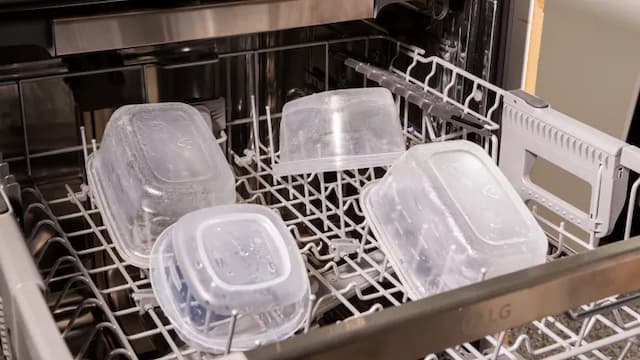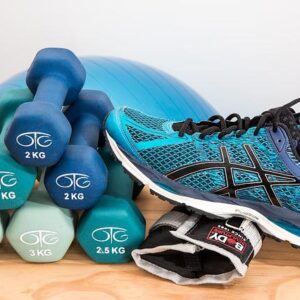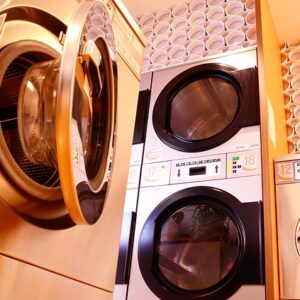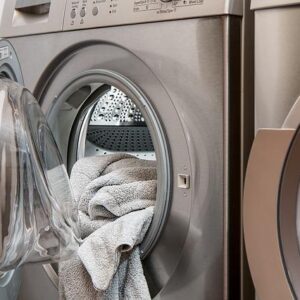As long as you purchased your Tupperware after 1979, your Tupperware should be dishwasher safe. In fact, most Tupperware will say “dishwasher safe”, or there will be a symbol to let you know. The shape of this symbol is a square box with a few plates or glasses inside, along with some lines or dots that stand for water.
If yours does not state specifically, wash them by hand or on the top rack to prevent them from becoming dislodged and falling into the heating element, where the plastic may warp due to the high heat.
See if you can regulate the temperature of your washing machine to help prevent warping to be extra safe. Reducing the heat also means using less electricity, which is better for the environment overall.
Table of Contents
How to Wash Tupperware in the Dishwasher?
You can easily tell if your Tupperware container is dishwasher safe if it says so on the label. Therefore, it’s crucial to understand how to wash your products in the dishwasher without causing damage.
Where there are fewer heating sources, put your Tupperware products. It’s also best to avoid washing your container on high heat and dry settings. Tupperware can warp or even melt when exposed to extremely hot temperatures.
You’ll find it challenging to close the lid when this occurs. Or worse, damage your dishwasher, which could make you end up having to install a new one.
It’s also a good idea to avoid setting your containers on the dishwasher’s lower rack. It is not advisable to subject them to high-pressure jets because doing so could result in the containers falling onto the hotter part of the dishwasher.
Remember that plastics don’t completely dry out in dishwashers as well. This means that you still need to towel-dry the containers after the cycle is finished before storing them. Or you can just put an air gap on your dishwasher to let them dry for a few hours.
The fact that dishwashers leave white marks on Tupperware is another thing that irritates many of their owners. Usually, these white scuffs are just signs of normal wear and tear.
However, they are probably more as a result of the dishwasher’s frequent use. The high-pressure jets clean the machine’s contents vigorously in order to clear its contents; as a result, the Tupperware has white dent marks.
Proper Way to Hand Wash Your Tupperware
Your Tupperware containers shouldn’t be too difficult to hand wash. They need more care than standard kitchenware, though.
- Rinse them with warm water. Grease from the food that you most recently used your container for can be removed with warm water.
- Scrub the dirt away.Clean the container and lid with a sponge or cloth that has been soapy. Make sure you get rid of all the food stains.
- Rinse and dry.Rinse your containers once more in warm water after cleaning them. Use a clean cloth to dry them instead of putting them on the rack to air dry.
When washing your Tupperware containers, avoid using abrasive sponges. Your containers’ exterior may be scratched by them. As a result of these scratches, food particles may become stuck, providing bacteria with a favorable environment in which to thrive.
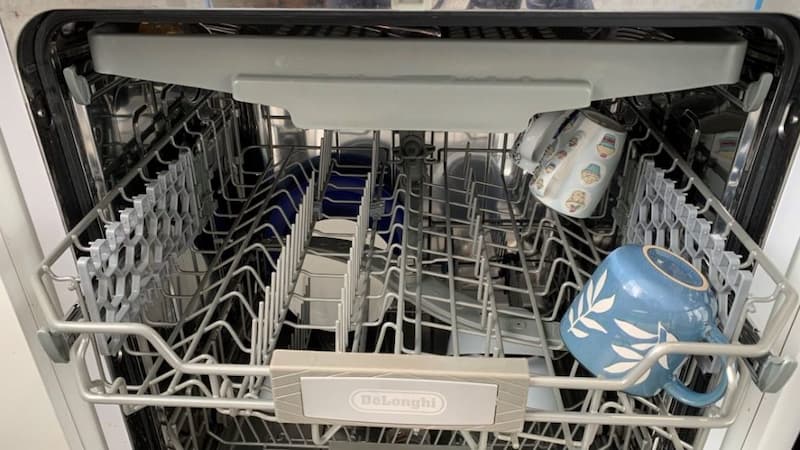
Does Tupperware Contain BPA?
BPA stands for Bisphenol A, a chemical primarily used in the production of epoxy resins and polycarbonate plastics. While there are varying opinions about the safety of BPA between health organizations, researchers as well as governmental agencies, the general opinion is that it is potentially harmful to human beings.
For instance, BPA may be harmful to the nervous system’s growth. Even some early research suggests a connection between breast cancer and BPA and issues with reproduction.
However, they are also a significant source of BPA. Plastics are still the material of choice for storing food and beverages. According to the Tupperware company, no BPA-containing products have been sold as of March 2010. However, this statement implies that products manufactured before 2010 may contain the chemical.
How to Identify BPA?
To identify if any of the Tupperware in your home contains BPA, looking for the following identifying characteristics of BPA can be useful:
- The product can be easily seen through.
- Containers labeled “microwave-safe” or “unbreakable”.
- It has a triangular symbol resembling the recycling symbol on the bottom with the Resin Identification Code number 7 in the center.
- There isn’t even a recycling number or resin identification code on it.
Containers that say “hand-wash only” on them may also be BPA-free.
It is not safe to microwave or store food in Tupperware products that contain BPA. Some containers are advertised as safe for microwave use, but this essentially just means they won’t melt. Heating food in plastic increases the danger of a chemical reaction happening, causing harmful material in your container to leach into your food.
You can change over to using glass for various purposes in your kitchen to be completely safe. Glass is safe for the dishwasher and microwave, does not leach any harmful substances, and does not corrode or deteriorate over time. Visit our guide, Life Without Plastic: Easy Tips for Everyone, for more advice on how to stop using plastic.
But you don’t have to get rid of any outdated containers you think might contain BPA. Besides holding leftovers, these containers can be used for other useful things around the house.
How to Store Your Tupperware?
Tupperware containers have so many wonderful qualities. It’s crucial to develop your ability to care for them because of this. And while these containers are not high-maintenance, it’s still going to help you even lengthen their life by following more of these tips below:
- Never close the lids.It is best to stack the lids and bases of your Tupperware containers separately when storing them. You’ll save a ton of space and organize much more easily as a result.
- Put them in overnight storage with newspaper.As was previously stated, the newspaper’s carbon can help to get rid of the container’s offensive odor. You might want to add some newspaper pages to the stack of Tupperware before placing it in a closed cabinet. The newspaper may be left and removed the following morning.
- Sort them by size before storing.Gather all the bases and lids and arrange them in your kitchen. For better organization, be sure to match lids and bases in accordance with their sizes.
- Ascertain that it is entirely dry.Tupperware can develop an unpleasant odor with just a little bit of moisture, especially if you store them in a closed cabinet. Therefore, make sure they are entirely dry before storing them by wiping with a clean cloth.
Bonus tip: We don’t see any reason why you shouldn’t give this technique a try; some Tupperware owners swear by it. Give the containers you’ve been using for about three months an overnight soak in water. Dry them by air or by cloth the following morning before putting them back in storage.
Why many use this method has a straightforward explanation. The biodegradable oil used to make Tupperware needs moisture. That moisture is what this process is supposed to provide.
Which Tupperware Containers Are Best?
Years ago, Tupperware wasn’t just a generic term for a plastic food storage container; it was a hugely well-known brand!
Even though that is not the brand, it became such a household name that most people now frequently refer to their food storage containers as Tupperware.
There are many brands available today; listed below are some of the most well-liked by buyers of food storage.
Tupperware

Tupperware is the original manufacturer of plastic food storage, and despite being a classic, the company still develops cutting-edge products to address particular needs, such as vented lids for microwave use, travel sets, and seasonal designs.
It does tend to be more expensive, but this is because its reputation for high-quality products makes it more expensive. Tupperware may be a great option if you’re looking for a food storage container that will last for a long time and that you can properly clean and maintain.
Rubbermaid
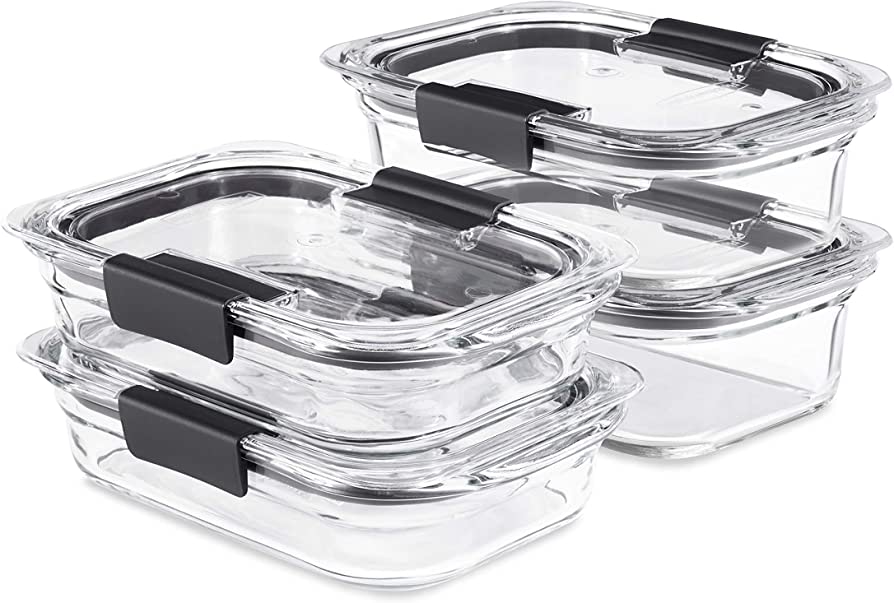
Rubbermaid provides many different sizes of plasticware in addition to sets, making it an affordable option. Although it isn’t the most durable option and will eventually stain like any other plastic container, it is still a common choice.
Rubbermaid would be a good choice if you frequently bring food to friends and family and don’t want to worry about having an expensive container returned, or if you like to throw away your plastic containers after leaving them in the refrigerator for too long.
Snapware

Snapware is leakproof and simple to stack thanks to a convenient locking feature that snaps shut. Given its greater durability compared to many others, the building might end up being more valuable in the long run. Snapware is a fantastic choice for people who keep a meticulously organized pantry or have a propensity to be rough on their containers.
The best option for you will depend on your needs; there are many wonderful options for plastic food storage containers available today. Each has advantages and disadvantages.
Think about what you need in terms of innovation, comfort, and durability.
Whatever you decide to use for meal preparation and food storage, be sure to clean it carefully to prevent damage and maintain its quality.
How Can You Tell If a Plastic Container is Dishwasher Safe?
Symbols and other markings that indicate whether a plastic food storage container is safe to be placed in the dishwasher are typically found on the bottom of the container. This eliminates the uncertainty surrounding how to correctly clean your container.
The most straightforward designation, of course, is a written message noting “Dishwasher Safe”. The images that indicate dishwasher compatibility are more difficult to interpret, but they all show glasses or dishes being rinsed under water.
When the water component is represented by lines above the dishes, only the top shelf should be used to store the container. If water is visible on the dishes as drops, either the top or bottom shelf may be used for the container.
There are a few other useful designations as well that are relevant to the use of your plasticware:
Microwave Safe
When storing leftovers in a plastic container with the intention of reheating them, it’s especially crucial to look for this designation. Look for a written message noting “Microwave Safe”, or a symbol with squiggly lines, either within a microwave or above a dish.
The best course of action is to replace your container with a new one if it is cracked or otherwise shows signs of wear.
Freezer Safe
Make sure your container is freezer-safe if you plan to store food there for more than just a week; many are not. This would be indicated by a written message noting “Freezer Safe”, or a snowflake.
Final Thoughts
Numerous products, including bakeware, cookware, and food storage containers, are produced by Tupperware, and nearly all of them are secure enough to be placed in the top rack of the dishwasher during a typical cycle of cleaning.
But don’t just take our word for it; always double-check with the product manual before attempting to place any Tupperware item in the dishwasher.

